More than a fortnight has elapsed since a devastating fire took 71 lives in the older part of Dhaka. Upon taking an in-depth look at the calamity's aftermath, people come across a bedlam. It comprises confusions, lack of planning, resentment at the shifting of the chemical factories responsible for the killer blaze to distant zones. A pall of gloom still pervades the greater Chawkbazar area. A month-long drive by Dhaka South City Corporation (DSCC) to shift the errant factories and warehouses to remote areas continues in full swing. The express aim is to keep the residential and other areas free of the catastrophes invited by these mostly illegal factories.
Something may have badly gone rotten in the long overdue measure. It's a highly unpalatable development, as the defiant chemical factories mustered the audacity to obstruct the authorities' step to relocate them. In coping with the violent opposition, a taskforce comprising 14 government agencies has been compelled to sever electricity, gas and water connections to these factories in the city's older parts. The action appears to have been proved fruitful. Sans the utility lines, a considerable number of the large and small chemical units have wound up their operation in the vast chemical and plastic goods hub grown illegally. The area includes far-flung neighbourhoods including Bakshibazar, Lalbagh, Siddique Bazar, Sadarghat, Shaheed Nagar etc. According to recent media reports, there are approximately 25,000 chemical and plastic factories and warehouses in Old Dhaka. Appallingly, 15000 of them are housed in residential buildings. Reliable sources put the percentage of the chemical warehouses having permits at 2 per cent, with the rest operating without licence from the city corporation. That a process of relocating these agents of death and destruction is in place once again should prompt the affected people to take heart. But the loopholes in the government plan, the developments stemming from the factory owners' resistance to shifting due to lack of preparation lead also to unease.
An irksome factor is that the ghost of the 2010 Nimtoli fire, claiming 124 lives, cannot apparently allow them to feel relieved completely. It takes time for people to come free of a dreadful trauma. In the aftermath of such blazes, the spectre of chemical-induced fire begins haunting the victims. Many in Dhaka now brace for disasters breaking out in the city's newer areas. In the face of an all-out offensive against the chemical warehouses and factories, a lot of them have allegedly shifted to obscure areas. Some have reportedly stashed their lethal chemicals in hidden places.
The government agencies in charge of the eviction drive have listed 29 'dangerous chemicals' that carry the potential for catastrophic consequences. Besides them, there are scores of other hazardous substances handled by the chemical and plastic factories and warehouses. All this stands for a hazard incarnate. Given this graveness of the matter, the authorities have started implementing the plan to set up two permanent chemical zones on the city's outskirts: one in Tongi, the other in Shyampur on Dhaka's south. Presumably, it's a long-term project. A similar programme taken up after the Nimtoli fire has fizzled out. Meanwhile, the authorities expect the chemical factory owners to relocate their dangerous chemical unit in Keraniganj. It's a stop-gap solution. Common wisdom says these cumbersome relocations leave space for crooked manoeuvring by dishonest traders. Nobody wants to see the recurrence of the Nimtoli factory-relocation fiasco. To speak plainly, it must not happen.


